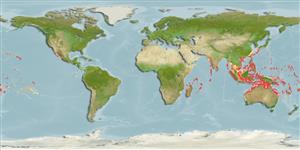Common names from other countries
Environment: milieu / climate zone / depth range / distribution range
Ökologie
seewasser riff-verbunden; standorttreu; tiefenbereich 0 - 60 m (Ref. 89972). Tropical; 35°N - 32°S
Indo-Pacific: East Africa to the Tuamoto Islands, north to the Izu Island, south to Lord Howe Island. Not found in the Red Sea, Hawaii, and the southern Pacific Ocean (Ref. 48391).
Size / Gewicht / Alter
Maturity: Lm ? range ? - ? cm
Max length : 11.5 cm TL Männchen/unbestimmt; (Ref. 26587)
Rückenflossenstacheln (insgesamt): 14; Rückenflossenweichstrahlen (insgesamt): 16-18; Afterflossenstacheln 3; Afterflossenweichstrahlen: 17 - 19.
Secretive species found in lagoon and seaward reef slopes in areas with rich coral growth. Found singly or in aggregations (Ref. 1602); forms harems of 3-7 individuals. Feeds on algae. Frequently exported through the aquarium trade (Ref. 48391). Minimum depth reported taken from Ref. 128797.
Life cycle and mating behavior
Geschlechtsreife | Fortpflanzung | Ablaichen | Eier | Fecundity | Larven
Myers, R.F., 1991. Micronesian reef fishes. Second Ed. Coral Graphics, Barrigada, Guam. 298 p. (Ref. 1602)
IUCN Rote Liste Status (Ref. 130435)
CITES (Ref. 128078)
Not Evaluated
Bedrohung für Menschen
Harmless
Nutzung durch Menschen
Fischereien: kleinfischerei; Aquarium: Kommerziell
Mehr Information
NamenSynonymeMetabolismusRäuberÖkotoxikologieFortpflanzungGeschlechtsreifeAblaichenFecundityEierEientwicklung
ReferenzenAquakulturAquakultur ProfilZuchtlinienGenetikElectrophoresesVererbbarkeitKrankheitenVerarbeitungMass conversion
Tools
Zusatzinformationen
Download XML
Internet Quellen
Estimates based on models
Preferred temperature (Ref.
115969): 24.6 - 28.8, mean 27.5 (based on 598 cells).
Phylogenetic diversity index (Ref.
82804): PD
50 = 0.5000 [Uniqueness, from 0.5 = low to 2.0 = high].
Bayesian length-weight: a=0.04467 (0.02396 - 0.08327), b=2.75 (2.59 - 2.91), in cm Total Length, based on LWR estimates for this species & (Sub)family-body (Ref.
93245).
Trophic level (Ref.
69278): 2.8 ±0.29 se; based on food items.
Widerstandsfähigkeit (Ref.
120179): mittel, Verdopplung der Population dauert 1,4 - 4,4 Jahre. (Preliminary K or Fecundity.).
Fishing Vulnerability (Ref.
59153): Low vulnerability (10 of 100).
